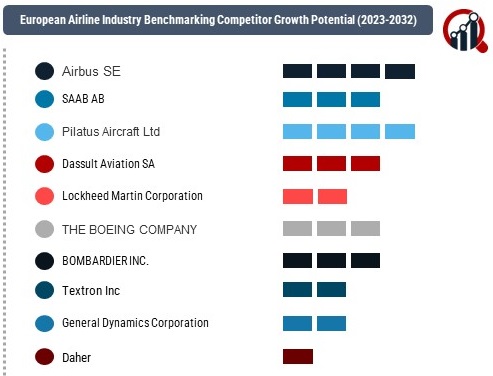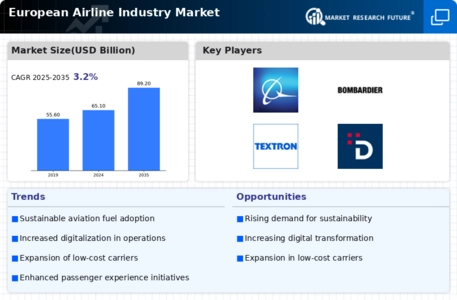Top Industry Leaders in the European Airline Industry Market

The European airline industry is a highly competitive and dynamic sector that plays a crucial role in connecting people and goods across the continent. Analyzing the competitive landscape reveals key players, their strategies, and recent developments within this complex market.
Key Players:
Airbus SE
SAAB AB
Pilatus Aircraft Ltd
Dassult Aviation SA
Leonardo SpA
Lockheed Martin Corporation
THE BOEING COMPANY
BOMBARDIER INC.
Textron Inc
General Dynamics Corporation
Daher
Embraer SA
Strategies Adopted:
The strategies adopted by key players in the European airline industry revolve around cost management, fleet optimization, customer experience enhancement, and strategic partnerships. Lufthansa Group, for instance, focuses on the integration of low-cost subsidiaries like Eurowings while maintaining the premium services offered by its flagship brand. IAG, formed through the merger of British Airways and Iberia, capitalizes on the synergies between its member airlines to achieve economies of scale. Cost-efficient carriers like Ryanair and easyJet prioritize point-to-point routes, keeping operational expenses low.
Market Share Analysis:
The European airline industry is influenced by factors such as route networks, passenger traffic, cost efficiency, and customer satisfaction. Companies excelling in providing extensive and well-connected route networks, operational efficiency, and high levels of customer satisfaction are better positioned to capture larger market shares. Collaborations with airports, regulatory compliance, and a focus on eco-friendly initiatives also play a role in determining market share.
News & Emerging Companies:
The European airline industry has witnessed the emergence of new entrants and innovative companies, particularly in the low-cost carrier segment. Emerging players like Wizz Air and Norwegian Air Shuttle have gained prominence by focusing on cost-effective operations and offering affordable travel options. Additionally, boutique carriers catering to niche markets and premium services have emerged, adding diversity to the competitive landscape.
Industry Trends:
The European airline sector highlights ongoing investment trends, including fleet modernization, sustainability initiatives, and digital transformation. Airlines invest significantly in newer, more fuel-efficient aircraft to reduce operating costs and environmental impact. The adoption of sustainable aviation fuels and carbon offset programs aligns with the industry's commitment to environmental responsibility. Digital initiatives, such as mobile apps, in-flight connectivity, and data analytics, enhance the overall customer experience and operational efficiency.
Competitive Scenario:
The European airline industry is characterized by a delicate balance between legacy carriers, low-cost operators, and regional airlines. Established players leverage their brand recognition, alliance memberships, and extensive route networks to maintain market share. Low-cost carriers, on the other hand, focus on price competitiveness, operational efficiency, and innovative approaches to gain market traction. Regional airlines play a vital role in connecting smaller airports and serving niche markets, contributing to the overall diversity of the industry.
Recent Development
The European airline industry experienced a significant development as Lufthansa Group announced a strategic partnership with a leading aviation technology company to enhance its digital capabilities. The collaboration aimed at optimizing operational processes, improving customer interactions, and leveraging data analytics for better decision-making. This development underscores Lufthansa's commitment to embracing digital transformation as a means of staying competitive in a rapidly evolving aviation landscape. The successful implementation is expected to contribute to the industry-wide trend of airlines investing in technology to enhance efficiency, customer satisfaction, and overall competitiveness.










